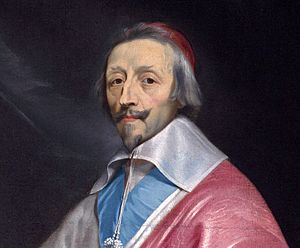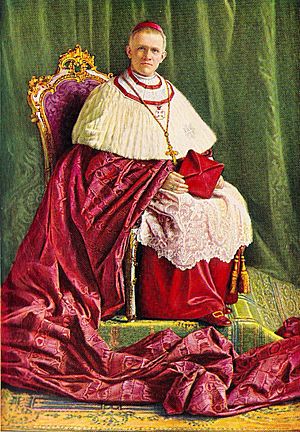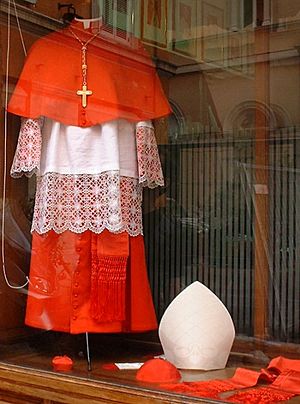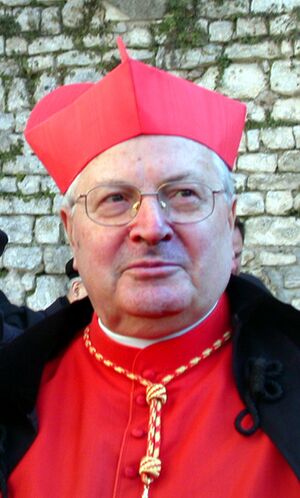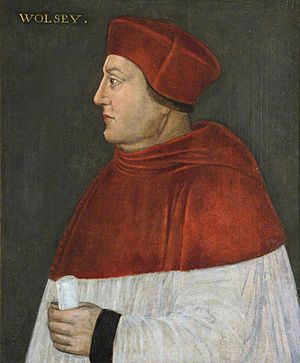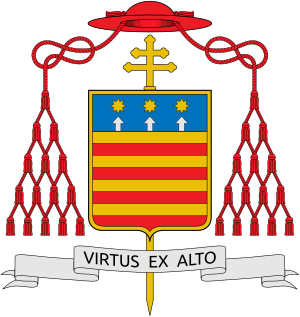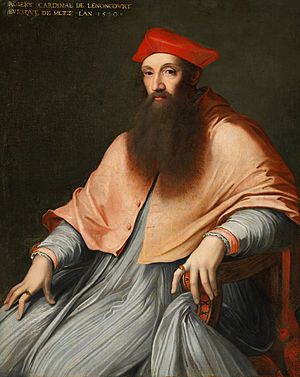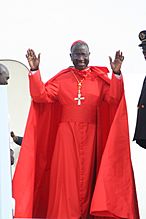Cardinal (Catholic Church) facts for kids
A cardinal is a very important leader in the Catholic Church. Cardinals are chosen by the pope and usually keep this special role for their whole lives. Together, they form a group called the College of Cardinals.
One of the most important jobs for cardinals is to elect a new pope. This happens in a special meeting called a conclave, usually after a pope has died or resigned. Most of the time, the new pope is chosen from among the cardinals themselves. During the time between popes, the College of Cardinals helps manage the daily tasks of the Church. Only cardinals under 80 years old can vote in a conclave. Cardinals also meet with the pope in gatherings called papal consistories to discuss important Church matters. New cardinals might also be chosen at these meetings. Many cardinals also lead different departments within the Roman Curia, which is like the central office of the Catholic Church.
Cardinals come from many different backgrounds. They are chosen for this role in addition to their other jobs in the Church. Most cardinals are bishops or archbishops who lead dioceses (areas of churches) around the world. These are often the most important dioceses in their countries. Others are titular bishops, who are current or former officials in the Roman Curia. A very small number are priests recognized by the pope for their great service. Church law usually requires them to become bishops before they are made cardinals, but sometimes the pope makes an exception. There are no strict rules for becoming a cardinal; the pope decides entirely. Since 1917, a person must be at least a priest to become a cardinal, but in the past, even laymen (people not ordained as clergy) could be cardinals.
Currently, [[List of current cardinals|there are List of current cardinals serving cardinals]]. Of these, List of current cardinals are able to vote in a conclave to elect a new pope.
Contents
Understanding Cardinals: Their History and Roles
The word "cardinal" comes from the Latin word cardo, which means "pivot" or "hinge." It was first used a long time ago to describe a bishop or priest who was brought into a church where they weren't originally from. In Rome, the first people called cardinals were deacons (church helpers) in the early 6th century. The word then started to mean "main" or "important." The name was also given to the senior priests in Rome's parish churches and to the bishops of the seven areas around the city. By the 8th century, Roman cardinals were a special group among the clergy. They helped run the Church in Rome and took part in papal ceremonies. In 769, a rule was made that only a cardinal could become the Bishop of Rome (the pope). Cardinals were allowed to wear the red hat by Pope Innocent IV in 1244.
In other cities, the name "cardinal" was also used as a special honor for certain churchmen. For example, in 747, Pope Pope Zacharias called the priests of Paris "cardinals" to show they were different from country clergy. This idea spread quickly. By the 9th century, many cities had a special group of clergy called cardinals. However, in 1567, Pope Pius V decided that only the cardinals of Rome could use this title.
In 1059, the right to elect the pope was given to the main clergy of Rome and the bishops of the seven areas around the city. In the 12th century, people from outside Rome began to be appointed as cardinals. Each of them was given a church in Rome as their "titular church," even if they were still based in their own diocese.
The term cardinal once meant any priest permanently assigned to a church, or the main priest of an important church. This came from the Latin word cardo (hinge), meaning "pivotal" or "chief." This meaning was used as early as the 9th century for the priests of the parishes in the diocese of Rome.
In 1563, the Council of Trent, led by Pope Pius IV, stressed how important it was to choose good cardinals. They said that the pope must choose only the best people as cardinals. They also said that the pope must appoint good and honest leaders to every church.
In the past, powerful rulers, especially the kings of France, had a say in who became a cardinal. It even became a tradition for some monarchs, like those of Austria, Spain, and France, to suggest one of their trusted clergy to become a cardinal. This was called a "crown-cardinal."
In early modern times, cardinals often played big roles in government. For example, in England, Cardinal Wolsey was King Henry VIII's chief minister. Cardinal Richelieu was so powerful that he practically ruled France for many years. His successor, Jules Mazarin, was also a cardinal. In Portugal, a cardinal named Henry even became king, which is the only time a cardinal has also been a king.
While some church leaders are often made cardinals, and some countries are guaranteed at least one cardinal by agreement, almost no church position automatically makes someone a cardinal. The main exception is the Patriarch of Lisbon. Since 1737, the Patriarch of Lisbon has the right to be made a cardinal at the next meeting after his appointment.
Papal Elections and Cardinal Numbers
In 1059, Pope Nicholas II gave cardinals the right to elect the Bishop of Rome (the pope) in a special document called In nomine Domini. For a while, only cardinal bishops had this power. But in 1179, the Third Lateran Council gave the right back to all cardinals.
In 1586, Pope Sixtus V limited the number of cardinals to 70. This included six cardinal bishops, 50 cardinal priests, and 14 cardinal deacons. However, Pope John XXIII went over this limit because he needed more cardinals to help run the Church. In 1970, Pope Paul VI decided that only cardinals under 80 years old could vote for a new pope. This rule started in 1971 and meant 25 cardinals could no longer vote. In 1975, he set the maximum number of voting cardinals at 120, but he did not limit the total number of cardinals.
Popes can sometimes set aside Church laws. They have often appointed more than 120 cardinals under the age of 80. For example, Pope John Paul II appointed as many as 135 voting cardinals in 2001 and 2003. Even though no more than 120 voting cardinals have ever participated in a conclave, most experts believe that if there were more than 120, they would all be able to vote.
Pope Paul VI also increased the number of cardinal bishops in 1965. He said that leaders of the Eastern Catholic Churches who became cardinals would also be cardinal bishops. In 2018, Pope Francis added more Latin Church cardinal bishops. He did this because the number of cardinal priests and deacons had grown a lot, but the number of cardinal bishops had not.
Titular Churches: A Cardinal's Roman Connection
Every cardinal is given a titular church when they are chosen. This is always a church in the city of Rome. A cardinal can move up through the ranks, from cardinal deacon to priest, and then to cardinal bishop. If they become a cardinal bishop, they get one of the areas (called suburbicarian sees) around Rome. The only exception is for leaders of the Eastern Catholic Churches.
Cardinals do not have power to manage or interfere with their titular churches. However, they can celebrate Mass, hear confessions, and lead visits there, working with the church staff. They often support their churches financially and stay in touch with the church leaders. The word "cardinal" comes from the Latin word "cardo," meaning a hinge or a door. Here, it means the "door" is the titular church, which connects the cardinal to the Roman clergy who elect the pope.
The Dean of the College of Cardinals, who is the highest-ranking cardinal, also receives the titular bishopric of Ostia, which is the main suburbicarian see. Cardinals who lead a specific church keep that church.
Different Kinds of Cardinals
Cardinal Bishops
Cardinal bishops are the highest rank of cardinals. Even though most cardinals today are bishops or archbishops, only a few are "cardinal bishops." For most of the last thousand years, there were six cardinal bishops. Each one oversaw one of the seven areas around Rome called suburbicarian sees. Since 1962, cardinal bishops only have a special connection to these areas, which are now run by other leaders.
Until 1961, the longest-serving cardinal could become a cardinal bishop when a spot opened up. But Pope John XXIII changed this in 1961, making it only the pope's decision to promote someone to cardinal bishop.
In 1965, Pope Paul VI decided that leaders of the Eastern Catholic Churches who became cardinals would also be cardinal bishops. They rank after the six Roman Rite cardinal bishops. These cardinal bishops keep their own church areas and are not given a Roman title.
In June 2018, Pope Francis increased the number of Latin Church cardinal bishops. He raised four cardinals to this rank, making their titular churches equal to the suburbicarian sees for a time. At that time, most of the cardinal bishops were over 80 and could not vote for a new pope. Pope Francis created another cardinal bishop in the same way in 2020, bringing the total number of Latin Church cardinal bishops to eleven.
The Dean of the College of Cardinals is the highest-ranking cardinal. Before 1965, this was the longest-serving cardinal bishop. Now, the Latin Church cardinal bishops elect the Dean from among themselves, and the pope approves their choice. The Vice-Dean is also elected.
Cardinal Priests
Cardinal priests are the largest group of cardinals. They rank above cardinal deacons and below cardinal bishops. Today, those named cardinal priests are usually bishops of important areas around the world, or they hold positions in the Roman Curia.
The name "cardinal priest" originally meant important priests of key churches in Rome. These priests were chosen by the pope to advise him as the Bishop of Rome. The Latin word cardo means "hinge" or "key." Over time, the term became special to Rome, referring to those who were trusted with electing the Bishop of Rome (the pope).
Even though the role of cardinal has grown beyond just Roman clergy, every cardinal priest has a titular church in Rome. This is true even if they are bishops or archbishops elsewhere. Pope Paul VI removed all administrative rights cardinals had over their titular churches. However, the cardinal's name and coat of arms are still displayed in the church. They are also expected to celebrate Mass and preach there if they are in Rome.
The number of cardinals was small for a long time. But in the 16th century, the group grew a lot. In 1587, Pope Sixtus V tried to stop this growth by setting the maximum size of the college at 70, including 50 cardinal priests. This limit was followed until 1958. When Pope John XXIII removed the limit, he started adding new churches to the list. Popes Paul VI and John Paul II continued this. Today, there are almost 150 titular churches.
The cardinal who has been a cardinal priest the longest is called the cardinal protopriest. He used to have certain ceremonial duties during the conclave. However, these duties have mostly stopped because he would usually be over 80 years old and unable to vote. The current cardinal protopriest is Michael Michai Kitbunchu from Thailand.
Cardinal Deacons
Cardinal deacons are the lowest-ranking cardinals. Cardinals given this rank are usually officials in the Roman Curia or priests who are chosen after their 80th birthday. Bishops who lead dioceses are usually made cardinal priests instead.
Cardinal deacons originally came from the seven deacons in the Pope's household. These deacons oversaw the Church's work in the seven districts of Rome during the early Middle Ages. At that time, the Church's administration was basically the government of Rome and provided all social services. They became known as "cardinal deacons" by the late 8th century. They were given the right to vote in papal elections and could even be elected pope in 769.
Cardinals who become deacons are mainly officials of the Roman Curia. Their number and influence have changed over the years. While they were mostly Italian in the past, they are now much more diverse. Their role in electing the pope is considered important because they are well-informed. Under the 1587 rule by Pope Sixtus V, there were 14 cardinal deacons. Later, the number increased.
Since 2005, there are over 50 churches recognized as cardinalatial deaconries, though there were only 30 cardinal deacons. Cardinal deacons have long had the right to become cardinal priests after they have been cardinal deacons for 10 years. When they become cardinal priests, they keep their original seniority from when they were first made cardinal deacons.
When not celebrating Mass but performing other church duties, like the special Urbi et Orbi blessing given by the pope, cardinal deacons can be recognized by the special robes called dalmatics they wear with a simple white hat (called a mitra simplex).
Cardinal Protodeacon: Announcing the New Pope
The cardinal protodeacon is the most senior cardinal deacon based on when they were appointed. If he is a cardinal who can vote and takes part in a conclave, he is the one who announces a new pope's election and name from the balcony of St. Peter's Basilica in Vatican City. The protodeacon also gives the pallium (a special scarf) to the new pope. In the past, he also crowned the pope with the papal tiara, but this crowning ceremony has not happened since Pope John Paul I in 1978. The current cardinal protodeacon is Renato Raffaele Martino.
Special Types of Cardinals
Camerlengo: Church Manager During Vacancy
The Cardinal Camerlengo of the Holy Roman Church has duties that are mainly limited to the time when the papacy is empty (when there is no pope). He is helped by the Vice-Camerlengo and other church officials. His job is to gather information about the financial state of all Church offices and present it to the College of Cardinals when they meet for the papal conclave.
Cardinals Who Are Not Bishops
Until 1918, any cleric, even one with only minor church roles, could become a cardinal. They would be part of the cardinal deacons. For example, in the 16th century, Reginald Pole was a cardinal for 18 years before he was ordained as a priest. The 1917 Code of Canon Law (Church law) stated that all cardinals, even cardinal deacons, had to be priests. Then, in 1962, Pope John XXIII made a rule that all cardinals must be consecrated as bishops, even if they are only priests when appointed. Because of these changes, the current Church law (from 1983) says that a cardinal must be at least a priest when appointed. If they are not already bishops, they must become one. However, some cardinals who are near or over 80 years old when appointed have been allowed to skip the rule of becoming a bishop. These cardinals were all appointed as cardinal deacons.
A cardinal who is not a bishop can still wear and use the special clothes and items of a bishop, like the mitre (tall hat), crozier (staff), and pectoral cross (cross worn on the chest). They also have a higher rank than patriarchs, archbishops, and bishops who are not cardinals. However, they cannot perform certain sacraments, like ordination, which are only for bishops. The important priests who have not been ordained bishops since 1962 were usually over 80 or close to it. So, no cardinal who was not a bishop has taken part in recent papal conclaves.
"Lay Cardinals": A Thing of the Past
In different times, there were cardinals who had only received the first step of becoming a cleric and minor church roles, but were not yet ordained as deacons or priests. Even though they were clerics, they were sometimes mistakenly called "lay cardinals" (meaning not ordained). Teodolfo Mertel was one of the last of these "lay cardinals." When he died in 1899, he was the last living cardinal who was not at least a priest. With the new Church law in 1917 by Pope Benedict XV, only those who are already priests or bishops can be appointed cardinals. Since the time of Pope John XXIII, a priest who is appointed a cardinal must become a bishop, unless the pope makes an exception.
Secret Cardinals: In Pectore
Besides the cardinals whose names are publicly known, the pope can also name secret cardinals, or cardinals in pectore (Latin for in the breast). This means their names are kept private. In the past, especially during times of conflict, popes would name cardinals without telling everyone their names until later. A cardinal named in pectore is known only to the pope. In modern times, popes have named cardinals in pectore to protect them or their communities from political problems. If things change, the pope can make the appointment public. That cardinal then has the same rank as those who were made cardinals at the time of his secret appointment. If a pope dies before revealing the identity of an in pectore cardinal, that person's status as a cardinal ends. The last pope known to have named a cardinal in pectore was Pope John Paul II. He named four, but one of them was never revealed.
What Cardinals Wear and Their Special Rights
- Special clothes cardinals wear
When wearing their special church clothes, a Latin Church cardinal wears scarlet (bright red) garments. This blood-like red color symbolizes a cardinal's readiness to die for their faith. Except for the white shirt (called a rochet), the red clothes include the long robe (cassock), a short cape (mozzetta), and a square hat (biretta) worn over a small red skullcap (zucchetto). A cardinal's biretta is special because it doesn't have a pompon or tassel like other clergy hats. Until the 1460s, cardinals usually wore a violet or blue cape unless they were allowed to wear red for papal business. Their everyday cassock is black but has red trim and a red sash. Sometimes, a cardinal wears a red cape called a ferraiolo. The bird called a cardinal is named after the red color of the cardinals' clothes.
Eastern Catholic cardinals continue to wear the traditional clothes of their own church. However, some might have red lining in their robes or wear red sashes.
In the past, at the meeting where the pope named a new cardinal, he would give them a special wide-brimmed hat called a galero. This tradition stopped in 1969, and now they receive the red biretta. However, in church symbols (heraldry), the red galero is still shown on a cardinal's coat of arms. Cardinals used to display the galero in their cathedral, and when a cardinal died, it would be hung from the ceiling above his tomb. Some cardinals still have a galero made, even if it's not officially part of their clothing.
To show their connection to the papacy, the pope gives each new cardinal a gold ring. Catholics traditionally kiss this ring when they greet a cardinal. Before a change by Pope John Paul II, each cardinal received a ring with a gem, usually a sapphire, and the pope's symbol engraved inside. Now, there is no gemstone, and the pope chooses the image on the outside. For example, under Pope Benedict XVI, it was a modern picture of Jesus' crucifixion. The ring also has the pope's coat of arms inside.
Cardinals have a special right in Church law called "privilege of forum." This means they cannot be judged by regular church courts. Only the pope can judge them in matters related to Church law. The pope either decides the case himself or asks a special court or department of the Roman Curia to do it. Without such permission, no church court can judge a cardinal.
Also, Church law allows cardinals to hear confessions anywhere, which is a special right. Other priests and bishops usually need permission from the local bishop to hear confessions in certain places.
See Also
 In Spanish: Cardenal para niños
In Spanish: Cardenal para niños
- Cardinal-Infante (disambiguation)
- Cardinal-nephew
- Cardinal protector
- Hierarchy of the Catholic Church
- List of current cardinals
- List of the creations of the cardinals



